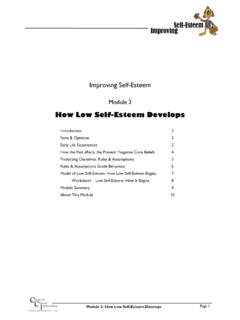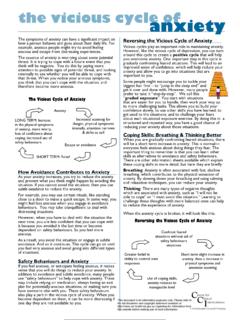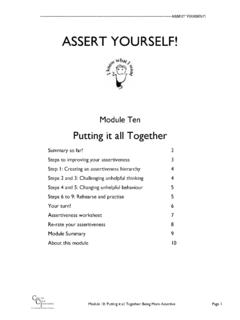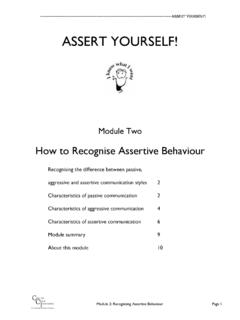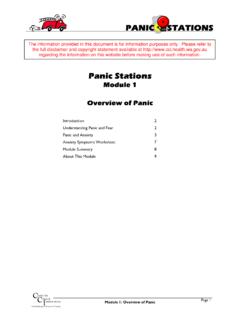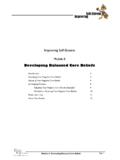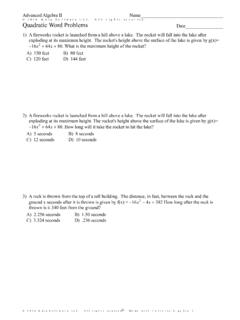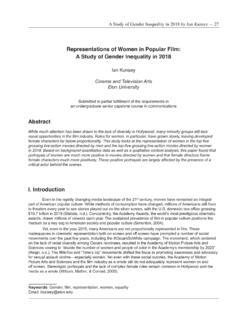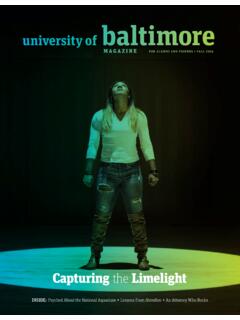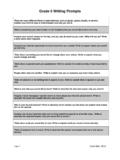Transcription of What is Imagery Rescripting - cci.health.wa.gov.au
1 Using Imagery Rescripting You will notice that with all the different upsetting images that people might be dealing with, the common response is to try to avoid the image, to push it away, to rid of it from our minds. Whilst this is a very understandable reaction, unfortunately avoiding these images usually makes things worse, making us very fearful of the image itself, giving the image power over us, so the image becomes much more than just an image . By working on these images using Imagery Rescripting , we are no longer avoiding them. Instead we are actively approaching them. That is, we close our eyes and run through the image in our mind, and then rewind the image and rewrite it rewrite the story, in whatever way we choose. In essence, we are taking charge of the image on our own terms. Now, some rewrites might be somewhat realistic in nature, and others will be pure fantasy. There are no limits to how you can change the image when it comes to Imagery Rescripting .
2 In this way it can be quite an empowering and creative process. You might rewrite the image one way, and decide you aren t satisfied with that, and so you can just rewind the image and try something else on for size. Some Rescripting will involve simply considering how you would like the image to be different, what you would like to do to the image to make it less threatening or for you to feel safer, or what you are needing in the image and finding ways to rewrite the story to meet that need. Some Rescripting , particularly if it is a past memory of something that happened in your younger years, might involve you entering the image as your now older and compassionate-self, and intervening in whatever way you want to help and support your younger-self. If that is too difficult initially, then your therapist may take the lead with this, and come in to support your younger-self in whatever way is needed to feel safe. C entre for C linical I nterventions Psychotherapy Research Training Imagery Rescripting is a technique that is often used in therapy to deal with upsetting or significant images that occupy our mind, and play a part in keeping our mental health problems going.
3 The problematic images that people often struggle with can be memories of the past, nightmares or future imaginings. Upsetting Memories If we have experienced an upsetting or traumatic event in the past, the memory of this event will often stay with us, intruding into our present life, colouring and tainting what we expect to happen now. Sometimes we refer to these images as ghosts or echoes from the past, and we can get very stuck in these memories. When something upsetting has happened to us, our mind can have a lot of trouble making sense of what has happened, and therefore keeps bringing up the memory as a way of trying to understand the event. In this way, the memory never gets laid to rest, as a bad thing that is firmly behind us. Because the memory is so upsetting, understandably we try to push it away whenever our mind brings it up. Our mind might also keep bringing up the memory as a way of keeping us on high alert, trying to protect us from the bad event ever happening again.
4 Upsetting Nightmares Many people will experience recurring nightmares or upsetting dreams. These can be the same dream over and over again, or different dreams that have the same upsetting theme. Understandably, people will often wake in high distress from such a dream, and try to push it out of their mind. They will often find it very difficult to go back to sleep, or may start to avoid going to sleep for fear of having the dream again. Upsetting Imaginings of the Future If we are fearful or dread something upcoming in the future, we might imagine in a lot of detail what we think will happen. We may see ourselves not coping, things going very badly, people responding to us in a very negative way, something awful happening to ourselves or a loved one, or other terrible catastrophes. Again, when we realise that such an awful picture is playing out in our mind, we will do what we can to turn the picture off. What is This document is for information purposes only.
5 Please refer to the full disclaimer and copyright statement available at regarding the information from this website before making use of such information. See website for more handouts and resources. Imagery Rescripting ? When someone rescripts a nightmare of falling from a tall building to their death, to instead having a superhero sweep in and rescue them what does this new picture mean to them? The new image conveys more helpful meanings like the nightmare is just a picture and nothing more , and I am in fact safe and secure . When someone rescripts an image of having a terrible panic attack on a future upcoming plane trip, to instead picturing their wise and strong-self entering the image and coaching them through managing their anxiety what does this new picture mean? The new image conveys more helpful meanings like I can cope with this anxiety, I can tolerate it, I know what to do . The Impact of Imagery Rescripting Clients who have successfully used Imagery Rescripting say things like: I am not as attached to the memory anymore ; It has taken the sting and heat out of it ; The image doesn t bother me now ; I m not scared of the memory now ; It is just an image, just a picture, I can play around with it and do what I like to it ; and The meaning of memories is malleable.
6 Imagery Rescripting is a bit like putting an awful photograph back into its album and back on the shelf where it belongs, rather than carrying the photo around in your front pocket all the time. We can finally relate to these images as just images , and put them to rest, so they have little impact on our daily life now. C entre for C linical I nterventions Psychotherapy Research Training The Aim of Imagery Rescripting Particularly if you are using Imagery Rescripting to deal with a past memory of a true upsetting or traumatic event, you might be thinking, what s the point of all this playing pretend ? That s not what happened in reality! Imagery Rescripting is not about pretending that a bad thing didn t happen. It is awful when someone goes through something upsetting and traumatic, and unfortunately the event itself can t be changed. However, what is also awful is when the memory of the bad thing continues to hurt the person over and over again.
7 This is where Imagery Rescripting comes in. The aim of Imagery Rescripting is to lay the memory to rest, by fully processing the image, rather than avoiding it, and when doing this to start seeing the image from new and different perspectives. Rewriting the image in new and wonderful ways, imagining things occurring that clearly didn t happen in reality and often are so fanciful that they couldn t happen in reality, seems to help with bringing new and different perspectives to the image. These new and different perspectives help to change what the image means to you. Changing the meaning of the image and hence the feelings attached to the image, is the main aim of Imagery Rescripting . The new picture you come up with during Imagery Rescripting is in some ways irrelevant. It doesn t matter how realistic or fanciful the picture is, what matters is what the picture means, what it represents and conveys. Capturing more helpful meaning in the new picture that is created during Rescripting , can have a powerful and beneficial impact on how we feel about a past memory, current nightmare or future difficult situation.
8 Imagery Rescripting Examples When someone rescripts a memory of being bullied as a child, and instead imagines their older-self shrinking the bully to the size of a mouse, and then hears their older-self say to them this isn t your fault, you are a wonderful child who doesn t deserve to be treated like this what does this new picture mean to them? The new image conveys more helpful meanings like I am valued ; it wasn t my fault , and there are people that are on my side looking out for me . Imagery Rescripting This document is for information purposes only. Please refer to the full disclaimer and copyright statement available at regarding the information from this website before making use of such information. See website for more handouts and resources.
